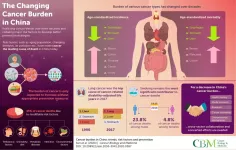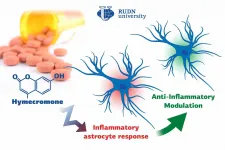INFORMATION:
Blood tests offer early indicator of severe COVID-19, study says
2021-02-26
(Press-News.org) When patients with COVID-19 arrive in emergency rooms, there are relatively few ways for doctors to predict which ones are more likely to become critically ill and require intensive care and which ones are more likely to enjoy a quick recovery.
New Yale research could help them identify important early clues. In a recent study, researchers report that a series of biomarkers, or biological signals, associated with white blood cell activation and obesity can predict severe outcomes in COVID-19 patients.
The findings appear in the Feb. 26 edition of Blood Advances.
"Patients with high levels of these markers were much more like to require care in the intensive care unit, require ventilation, or die due to their COVID-19," said Dr. Hyung Chun, the lead author, an associate professor of medicine in cardiovascular medicine and pathology and director of translational research at the Yale Pulmonary Vascular Disease Program.
Previously, a few laboratory studies had identified possible indicators of severe COVID-19, including D-dimer levels, a measure of blood coagulation, and levels of proteins known as cytokines, which are released as part of inflammatory responses in the body. However, until now, no laboratory marker could predict which patients with COVID-19 would eventually become critically ill prior to showing clinical signs and symptoms of severe disease.
For the new study, Yale researchers used proteomic profiling -- a screen for multiple proteins within the blood -- to analyze samples taken from 100 patients who would go on to experience different levels of COVID-19 severity. In all cases, the blood samples were collected on the patients' first day of admission. The researchers also analyzed clinical data for over 3,000 additional patients with COVID-19 within the Yale New Haven Hospital system.
They found that five proteins (resistin, lipocalin-2, HGF, IL-8, and G-CSF) that are associated with neutrophils, a type of white blood cell, were elevated in the COVID-19 patients who later became critically ill. Many of these proteins had previously been associated with obesity but not with COVID-19 or other viral illnesses.
Notably, the elevated neutrophil biomarkers for patients who would go on to experience more serious symptoms were evident before those symptoms appeared. All COVID-19 patients who were admitted or transferred to the ICU had elevated neutrophil activation markers, while these biomarkers remained low for patients who never developed severe illness. None of the patients with lower neutrophil biomarker levels died.
"This is one of the first demonstrations that a set of biomarkers in the blood of COVID patients can predict eventual ICU admission, even before such patients become critically ill," said study author Dr. Alfred Lee, associate professor of medicine in hematology, director of the Yale Medical Oncology-Hematology Fellowship Program, and a member of the Yale Cancer Center.
Having early knowledge of these indicators could significantly improve patient treatment, the researchers said.
"If a diagnostic test [for these biomarkers] could be ordered early, it could give us a better sense of who is more likely to become critically ill and will benefit from a higher level of care and consideration for therapies that affect the immune system early on in their hospitalization," said Chun. "Many of these drugs do carry potential side effects, and these tests may help identify those patients who would benefit the most."
The study also underscores the connection between COVID-19 and obesity, researchers said. The Centers for Disease Control and Prevention notes that obesity and severe obesity increase risk of severe illness from COVID-19. Obesity triples the risk of hospitalization from COVID-19, and levels of body mass index has been found to correlate with the risk of death from COVID-19.
Neutrophils are inflammatory cells, said Lee, so it makes sense that they would be elevated in the context of both obesity -- which involves chronic, low-grade inflammation -- and COVID-19, which causes hyperinflammation in the most severe cases, leading to tissue damage and organ failure.
"There are also signs that neutrophils might participate in thrombosis or blood clotting," said Lee, another troubling hallmark of COVID-19.
The researchers will expand their study into the relationship between biomarkers and COVID-19 by looking at patients who have recovered from acute illness.
"We are hoping these findings motivate other groups to look at their own patient populations," said Chun, adding that they'll need additional validation studies that would support developing diagnostic tests for these biomarkers.
The research involved collaborators from across many different Yale departments, including Matthew L. Meizlish, an M.D.-Ph.D. student; Dr. Alex Pine, an assistant professor of medicine in hematology and staff physician at the VA Medical Center in West Haven; Jason Bishai, a graduate student; Hanming Zhang and C-Hong Chang, postdoctoral fellows; and Dr. David van Djik, an assistant professor of medicine in cardiology.
"The evolution of our findings really shows the power of collaboration, which has emerged as one hopeful aspect of this devastating pandemic that we will continue to harness for the benefit of the patients," said Lee.
ELSE PRESS RELEASES FROM THIS DATE:
New research finds exercise may help slow memory loss for people living with Alzheimer's dementia
2021-02-26
PHOENIX, Arizona, February 26, 2021- Promising new research shows aerobic exercise may help slow memory loss for older adults living with Alzheimer's dementia.
ASU Edson College of Nursing and Health Innovation Professor Fang Yu led a pilot randomized control trial that included 96 older adults living with mild to moderate Alzheimer's dementia.
Participants were randomized to either a cycling (stationary bike) or stretching intervention for six months. Using the Alzheimer's Disease Assessment Scale-Cognition (ADAS-Cog) to assess cognition, the results of the trial were substantial.
The six-month change in ADAS-Cog was 1.0±4.6 (cycling) and 0.1±4.1 (stretching), which were both significantly ...
Using neutron scattering to better understand milk composition
2021-02-26
Neutron scattering is a technique commonly used in physics and biology to understand the composition of complex multicomponent mixtures and is increasingly being used to study applied materials such as food. A new paper published in EPJ E by Gregory N Smith, Niels Bohr Institute, University of Copenhagen, Denmark, shows an example of neutron scattering in the area of food science. Smith uses neutron scattering to better investigate casein micelles in milk, with the aim of developing an approach for future research.
Smith, also a researcher at the ISIS Neutron and Muon Source in ...
Unburdening China of cancer: Trend analysis to assist prevention measures
2021-02-26
The past century or so has seen unprecedented technological, scientific, and sociological evolution worldwide. These have accompanied global shifts in people's lifestyles and rapid changes in the environment, both natural and man-made. An unfavorable consequence of these alterations has been the increasing burden of cancer on human society.
As the country with the largest population, China has borne this burden heavily. Despite the massive progress China has made in healthcare since the 1950s, cancer has become the leading killer in the country. ...
Measuring the tRNA world
2021-02-26
Transfer RNAs (tRNAs) deliver specific amino acids to ribosomes during translation of messenger RNA into proteins. The abundance of tRNAs can therefore have a profound impact on cell physiology, but measuring the amount of each tRNA in cells has been limited by technical challenges. Researchers at the Max Planck Institute of Biochemistry have now overcome these limitations with mim-tRNAseq, a method that can be used to quantify tRNAs in any organism and will help improve our understanding of tRNA regulation in health and disease.
A cell contains several hundred thousand tRNA molecules, each of which consists of only 70 to 90 nucleotides folded into a cloverleaf-like pattern. At one end, tRNAs carry one of the twenty amino acids that serve as protein building blocks, while the ...
Household transmission of SARS-CoV-2
2021-02-26
What The Study Did: Researchers investigated whether home addresses recorded in the electronic medical record could be used to accurately estimate transmission risk of SARS-CoV-2 and identify risk factors for transmission.
Authors: Joshua P. Metlay, M.D., Ph.D., of Massachusetts General Hospital in Boston, is the corresponding author.
To access the embargoed study: Visit our For The Media website at this link https://media.jamanetwork.com/
(doi:10.1001/jamanetworkopen.2021.0304)
Editor's Note: Please see the article for additional information, including other authors, author contributions and affiliations, conflict of interest and financial ...
When young people start smoking
2021-02-26
What The Study Did: Researchers in this observational study assess at what age young people ages 12 to 17 start using cigarettes.
Authors: Adriana Pérez, Ph.D., of the University of Texas Health Science Center at Houston in Austin, is the corresponding author.
To access the embargoed study: Visit our For The Media website at this link https://media.jamanetwork.com/
(doi:10.1001/jamanetworkopen.2021.0218)
Editor's Note: The article includes conflicts of interest and funding/support disclosures. Please see the article for additional information, including other authors, author contributions and affiliations, conflict of interest and financial disclosures, and funding and support.
INFORMATION:
Media advisory: The full study is linked to ...
Study finds link between racial, socioeconomic factors and atrial fibrillation treatment
2021-02-26
PHILADELPHIA-- Even though the use of rhythm control strategies for treating Paroxysmal Atrial Fibrillation (AF), a common abnormal heart rhythm, have increased overall in the United States, patients from racial and ethnic minority groups and those with lower income were less likely to receive rhythm control treatment - often the preferred treatment - according to new research from the Perelman School of Medicine at the University of Pennsylvania. The study is published in the JAMA Network Open.
"Research has demonstrated the pervasive impact of structural racism on health outcomes among minoritized patients. We know, for instance, that there is less use of novel cardiovascular therapies among Black, Latinx, and patients of lower socioeconomic ...
Finding their comfort zone
2021-02-26
A Mason Engineering researcher has discovered that artificial microswimmers accumulate where their speed is minimized, an idea that could have implications for improving the efficacy of targeted cancer therapy.
Jeff Moran, an assistant professor of mechanical engineering in the Volgenau School of Engineering, and colleagues from the University of Washington in Seattle studied self-propelled half-platinum/half-gold rods that "swim" in water using hydrogen peroxide as a fuel. The more peroxide there is, the faster the swimming; without peroxide in pure water, the rods don't swim.
In this work, they set out to understand ...
Genes identified that increase the risk of obesity but also protect against disease
2021-02-26
People living with obesity tend to have unhealthy glucose and lipid levels in their blood, as well as high blood pressure. As a result, they are more at risk of cardiovascular and metabolic diseases. But scientists have observed that up to 45% of people living with obesity have healthy blood pressure and glucose and lipid levels, and therefore may not be at high risk of disease. The reason why this group of people with obesity remain healthy, has been poorly understood.
But now a team of researchers - led by scientists at the University of Copenhagen and Icahn School of Medicine ...
Biologists from RUDN University suggested a new substance to suppress neuroinflammation
2021-02-26
Biologists from RUDN University confirmed that a well-known spasmolytic drug called hymecromone can suppress the inflammatory response in astrocytes, important glial cells of the central nervous system. Potentially, it could be used to develop medications against Alzheimer's disease and other neurodegenerative conditions. The results of the study were published in the International Journal of Molecular Sciences.
All pathological processes in the nervous system, such as neurodegenerative diseases, injuries, or intoxications, are associated with inflammations. ...



